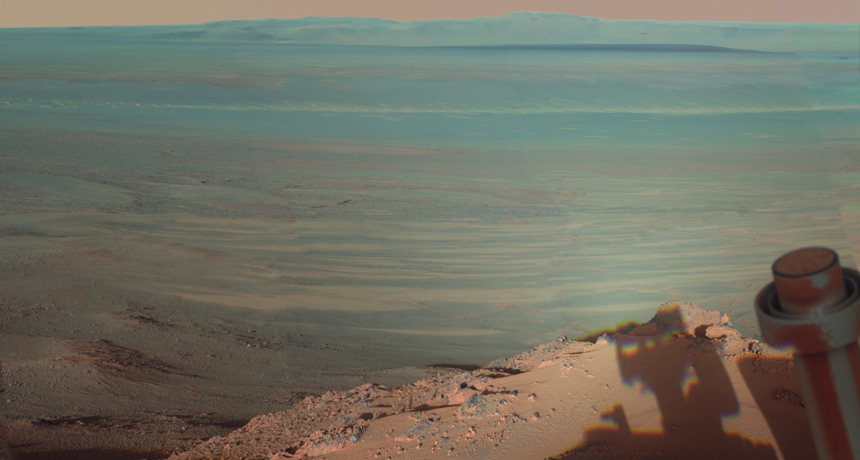New evidence of a wet Mars
Rover finds signs of water in Martian rocks

The Mars rover Opportunity looks over Endeavour Crater, where it turned up signs of ancient water. Scientists created this image by combining photos taken with different filters on the rover’s panoramic camera.
NASA/JPL-CALTECH/CORNELL/ARIZONA STATE UNIV
Ten years ago, a golf-cart-sized science lab on wheels started to roll across the surface of Mars. Within three months of landing, this Opportunity rover found signs that water had once pooled on the Red Planet. Fast forward to 2014, and the rover is still going strong. And it’s still finding evidence that water flowed on Mars — but not recently. The traces Opportunity has just found suggest that water might have existed some 4 billion years ago.
That water would not have been overly salty or acidic, scientists also report. In other words: Life might once have thrived on Mars.
There’s no actual water present now — certainly no Martian waterfalls or alien pools. But the rover has found soil minerals that normally form only in watery conditions.
Opportunity mined its latest data from the rim of Endeavour Crater. This giant bowl-sized formation is nearly as wide as 250 football fields laid end to end. (The crater probably formed when a meteorite smashed into the planet, long ago.)
The crater isn’t the first place scientists found signs of water that could have supported life. In 2013, a second rover, Curiosity, found other rocky clues at another, distant crater. Though both rovers work on the same planet, Curiosity is far from Opportunity, notes Bethany Ehlmann. Part of the Curiosity team, she’s a planetary geologist at the California Institute of Technology in Pasadena.
“At two landing sites on completely different sides of the planet, we now see evidence for these very [mild], water-rich environments,” Ehlmann told Science News. And that, she adds, “says a lot about how prevalent life could have been.”
Opportunity didn’t just stumble upon the telltale minerals. A spacecraft orbiting Mars had snapped pictures of them on the crater rim. Raymond Arvidson and his coworkers sent the rover over to check the minerals out. A planetary geologist, Arvidson works at Washington University in St. Louis.
When the rover arrived at the right spot, it found rocks with unusual cracks. Opportunity used a tool to grind up the rocks. Then it analyzed the minerals inside.
Data from the rock began, layer by layer, to tell a story about Mars’ watery history.
“The deeper we went, the more it looked like aluminum clay,” Arvidson told Science News. Such clay requires water to form. What’s more, he added, minerals like aluminum clay only form in water that is mild enough to support life. His team reported its findings Jan. 24 in the research journal Science.
Opportunity’s mission was originally planned as a three-month tour of Mars. This discovery on its 10-year anniversary shows that the little rover still has something to say about Mars.
Indeed, Arvidson told Science News, “I can’t believe this vehicle is still going.”
Power Words
crater A large, bowl-shaped cavity in the ground or on the surface of a planet or the moon. They are typically caused by an explosion or the impact of a meteorite or other celestial body.
geology The study of Earth’s physical structure and substance, its history and the processes that act on it. People who work in this field are known as geologists. Planetary geology is the science of studying the same things about other planets.
meteor A lump of rock or metal from space. In space it is known as a meteoroid. When you see it in the sky it is a meteor. And when it hits the ground it is called a meteorite.
mineral A chemical compound that is solid and stable at room temperatures and has a specific formula, or recipe (with atoms occurring in certain proportions) and a specific crystalline structure (meaning that its atoms are organized in certain regular three-dimensional patterns).
rover A carlike vehicle, such as those designed by NASA to travel across the surface of the moon or some planet without a human driver. Some rovers also can perform computer-driven science experiments.







